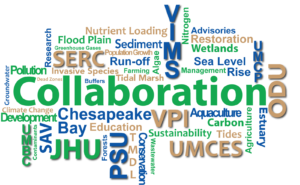 Stay up to date on the latest research around the Chesapeake with current Collaborative Research Around the Bay (CRaB) articles of our Chesapeake Quarterly newsletter. Here we highlight collaborative projects involving investigators from two or more CRC member institutions, whether recently completed, on-going, or newly initiated.
Stay up to date on the latest research around the Chesapeake with current Collaborative Research Around the Bay (CRaB) articles of our Chesapeake Quarterly newsletter. Here we highlight collaborative projects involving investigators from two or more CRC member institutions, whether recently completed, on-going, or newly initiated.
COVID-19 Response and Resources
How member institutions are managing under the new COVID-19 restrictions As states across the U.S. have issued social distancing orders to slow the spread of the COronaVIrus Disease 2019 (also known as COVID-19), universities and research centers have had to make major adjustments to their scientific operations. Like everybody else, this is also true for the member institutions that make up the Chesapeake Research Consortium. “Collaborative Research around the Bay” or CRaB is one of our most popular newsletter sections, where the...
read moreSAV in the Bay
Aerial SAV Surveys Support Collaborative Science, Management, and Restoration Submerged aquatic vegetation (SAV) is a vital component in the health of the Chesapeake Bay and worldwide coastal ecosystems. The SAV program, centered at the Virginia Institute of Marine Science (VIMS) is world-renowned for its monitoring and restoration projects. Robert “JJ” Orth, program director of the SAV monitoring and restoration program, started the program in 1978 which has made many important contributions in understanding the importance of SAV in...
read more10 Billion Oysters
Working Together to Keep Oysters Thriving in the Bay A thriving oyster population is vital to a healthy Chesapeake Bay. As a keystone species, oysters are necessary for filtering water and providing critical habitat for other species in the Bay. The Chesapeake Oyster Alliance is a coalition of partners that includes non-profits, universities, oyster farmers, and others, working toward adding 10 billion oysters to the Chesapeake Bay by 2025. Audrey Swanenberg, manager of the Chesapeake Oyster Alliance, spoke about the formation of the...
read moreSTAC Climate Synthesis
Major Climate Change Research Synthesis Kicks Off in the Chesapeake Climate change continues to complicate how models of the Chesapeake Bay predict the future. The Chesapeake Bay Program’s Scientific and Technical Advisory Committee (STAC) recently began a program to support scientists grappling with these uncertainties by funding short scientific syntheses around climate change issues in the Chesapeake Bay. This year, STAC funded two of these syntheses. Zachary Easton of Virginia Tech will lead a science synthesis on the effects of...
read moreThe Odum Legacy
How One Family Shaped Bay Research: Tracking the Odum Lineage The Odum name has been largely synonymous with ecology for decades. Despite that, many younger scientists may not be fully aware of the Odum family’s tremendous contributions to the field of ecology and specifically, the implications of their research on how the Chesapeake Bay is managed. Brothers, Howard “H.T.” and Eugene Odum, along with Eugene’s son, Bill, left a legacy that influences ecosystem management around the world. Lucky for us, many of the Chesapeake’s leading...
read moreWetland Creation Tool
Researchers from Old Dominion University (ODU), Virginia Tech (VT), and the University of Kentucky have created a software program that can help determine the best places and designs to create freshwater wetlands. The tool, called Wetbud, is free and easy to use for anyone, particularly engineers, scientists and regulators. It works by pooling data on water flows, slopes, evaporation, weather, soil, and topography to calculate the water inputs and outputs from a particular site and predict how an area will behave under normal, wet, and dry...
read more10-Year Nutrient Pollution Proposal
As those involved with the Consortium are well aware, nutrient pollution is one of the ‘grand challenges’ of our time. It is a particularly vexing problem given the complex web of ecological, social and economic factors involved. Despite significant attention being paid to addressing nutrient pollution by governments agencies, industry, non-governmental organizations and other stakeholders, important work remains. In order to address these issues, a diverse team of researchers is applying for an NSF Engineering Research Center grant. ERCs are...
read moreOyster Aquaculture and Disease
Scientists and managers have long thought that disease spreads from oyster aquaculture to wild populations. New research, however, has shown that aquaculture operations can actually limit the spread of diseases like dermo. The team, including Tal Ben-Horin of the University of Rhode Island (URI), Colleen Burge of University of Maryland Baltimore County (UMBC), Ryan Carnegie of the Virginia Institute of Marine Science (VIMS), among others, recently published their findings in Aquaculture Environment Interactions. Many stakeholders opposed to...
read moreUpdate on MARISA
NOAA Research Consortium Delivers New Reports The Mid-Atlantic Regional Integrated Sciences and Assessments (MARISA) recently published a summary of Chesapeake Bay Climate Impacts for the fall season of 2018. MARISA is a consortium of research organizations, led by the nonprofit RAND Corporation and funded by a 5-year grant from NOAA. As stated on its website, its mission is to “help communities in the Mid-Atlantic region become more resilient to a changing climate through improved data, place-based decision support, and public...
read moreRecent Quarterly article on CBP Diversity Program
Although diversity has been a priority at Chesapeake Bay institutions for many years, the Chesapeake Bay Program (CBP) recently committed to a Diversity Directive to further promote increased diversity throughout the CBP community. In 2016, the Alliance for the Chesapeake Bay released the results of its first-ever diversity profile after surveying approximately 750 people who work with or for the Chesapeake Bay Program (CBP) partnership. That survey revealed that “84% of respondents identified as white, while just 13% of respondents...
read more![[Old] Chesapeake Research Consortium](https://chesapeake.org/wp-content/uploads/2017/01/LogoForDarkBack.png)
